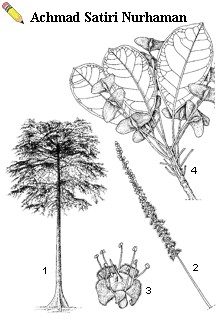Record Number
4732
PROSEA Handbook Number
5(2): Timber trees; Minor commercial timbers
Taxon
Terminalia superba Engl. & Diels
This article should be read together with the article on the genus: Terminalia in the Handbook volume indicated above in this database.
This article should be read together with the article on the genus: Terminalia in the Handbook volume indicated above in this database.
Protologue
Monogr. Afr. Pflanzenfam. 4: 26, t. 14B (1900).
Synonyms
Terminalia altissima A. Chev. (1909).
Vernacular Names
Afara, white afara (En). Korina (Am). Limba, fraké (Fr).
Distribution
Native to west tropical Africa from Sierra Leone to western Congo and northern Angola (Cabinda); planted in plantations both within and outside its natural range, e.g. in South and Central America, central and east Africa, Hawaii, Fiji and the Solomon Islands. Within the Malesian region further trials exist in Sabah, Kalimantan and the Philippines.
Uses
Terminalia superba is an important source of timber in Africa; the wood is used mainly as core and face veneer for plywood production. It is a promising fast-growing plantation species.
Observations
A large briefly deciduous tree up to 50 m tall, bole cylindrical, straight, branchless for up to 35 m, up to 120(—160) cm in diameter, with plank buttresses up to 6 m high, bark surface smooth, flaking off in small patches, greyish, inner bark yellowish; leaves obovate, (4—)6—14(—20) cm 2.5—7(—10) cm, glabrous, cuneate at base, with (4—)6—8 pairs of secondary veins, petiole (1.5—)3—5(—7) cm long; flowers in an axillary spike 7—20 cm long, calyx tube tomentose; fruit broader than long, 1.5—2.5 cm 4—7 cm, glabrous, broadly 2-winged. Terminalia superba demands light and grows gregariously in semi-deciduous or evergreen, usually secondary forest and in clearings, up to 1000 m altitude. The sapwood is pale brown, the heartwood dark brown. The density of the wood is 480—650 kg/m3 at 12% moisture content.
Image
 | Terminalia superba Engl. & Diels – 1, tree habit; 2, inflorescence; 3, flower; 4, fruiting twig. |
Selected Sources
[159]Fenton, R., Roper, R.E. & Watt, G.R., 1977. Lowland tropical hardwoods. An annotated bibliography of selected species with plantation potential. External Aid Division, Ministry of Foreign Affairs, Wellington. 420 pp.
[210]Groulez, J. & Wood, P.J., 1985. Terminalia superba, a monograph. Commonwealth Forestry Institute, University of Oxford & Centre Technique Forestier Tropical, Nogent-sur-Marne. 77 pp.
[348]Lamprecht, H., 1989. Silviculture in the tropics; tropical forest ecosystems and their tree species, possibilities and methods for their long-term utilization. Deutsche Gesellschaft für Technische Zusammenarbeit (GTZ) GmbH, Eschborn. 296 pp
[359]Leakey, R.R.B., 1987. Clonal forestry in the tropics – a review of developments, strategies and opportunities. Commonwealth Forestry Review 66(1): 61–75.
[375]Liben, L., 1983. Combrétacées. Flore du Cameroun 25 [Combretaceae. Flora of Cameroon 25]. Délégation Générale à la Recherche Scientifique et Technique (DGRST), Yaoundé. 98 pp.
[386]Longman, K.A. & Jeník, J., 1987. Tropical forest and its environment. 2nd edition. Longman Scientific and Technical, Essex. 347 pp.
[666]van Vliet, G.J.C.M., 1979. Wood anatomy of the Combretaceae. Blumea 25: 141–223.
[681]Voorhoeve, A.G., 1965. Liberian high forest trees. Pudoc, Wageningen. 416 pp.
[210]Groulez, J. & Wood, P.J., 1985. Terminalia superba, a monograph. Commonwealth Forestry Institute, University of Oxford & Centre Technique Forestier Tropical, Nogent-sur-Marne. 77 pp.
[348]Lamprecht, H., 1989. Silviculture in the tropics; tropical forest ecosystems and their tree species, possibilities and methods for their long-term utilization. Deutsche Gesellschaft für Technische Zusammenarbeit (GTZ) GmbH, Eschborn. 296 pp
[359]Leakey, R.R.B., 1987. Clonal forestry in the tropics – a review of developments, strategies and opportunities. Commonwealth Forestry Review 66(1): 61–75.
[375]Liben, L., 1983. Combrétacées. Flore du Cameroun 25 [Combretaceae. Flora of Cameroon 25]. Délégation Générale à la Recherche Scientifique et Technique (DGRST), Yaoundé. 98 pp.
[386]Longman, K.A. & Jeník, J., 1987. Tropical forest and its environment. 2nd edition. Longman Scientific and Technical, Essex. 347 pp.
[666]van Vliet, G.J.C.M., 1979. Wood anatomy of the Combretaceae. Blumea 25: 141–223.
[681]Voorhoeve, A.G., 1965. Liberian high forest trees. Pudoc, Wageningen. 416 pp.
Author(s)
M.S.M. Sosef
Correct Citation of this Article
Sosef, M.S.M., 1995. Terminalia superba Engl. & Diels. In: Lemmens, R.H.M.J., Soerianegara, I. and Wong, W.C. (Editors): Plant Resources of South-East Asia No 5(2): Timber trees; Minor commercial timbers. PROSEA Foundation, Bogor, Indonesia. Database record: prota4u.org/prosea

All texts are licensed under a Creative Commons Attribution-Noncommercial-Share Alike 3.0 Netherlands License
This license does not include the illustrations (Maps,drawings,pictures); these remain all under copyright.